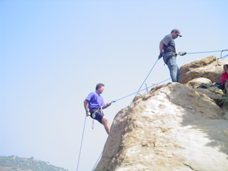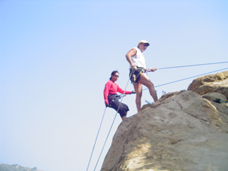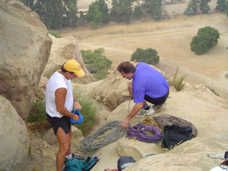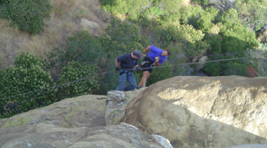|
ABSEILING Abseiling is one of the highlights of adventure racing. Everyone wants to get to the ropes. We have to ascend and that is just ok, but rappelling now that is fun! The biggest rappel I have done is in Primal Quest Utah at 450 feet. I am actually a little afraid of heights (well I used to be) and that one was scary. What Stops You When abseiling or rappelling, the rope and ATC holds the weight of the person constantly, which makes this sport slightly different from rock climbing. Rock climbing, caving, cayoneering or mountaineering also use rappelling frequently. For example, rock climbers must abseil when getting back to the base of a climb or getting to a point to follow a new path. The sport can be very dangerous and presents many dangerous risks to individuals who are not as experienced. So be sure you hook up with some knowledgeable staff. Do not attempt rappelling alone!One of the dangers is in the ATC. If you let go of the rope your rope is going to slide right through the ATC. This is why you are often belayed. This means someone on the bottom is ready to pull the rope taunt if you fall and this will stop you. This is called a firemans' belay. Knowledge The most vital part is being knowledgeable in how the sport works, and making sure that the surface that is being used is sturdy and not eroding. Cayoneers who explore watercourses on mountains have to rappel near waterfalls or cliffs to descend instead of jumping. Those who cave a lot also abseil where necessary. Besides sports, there are many day-to-day professions that use rappelling. Commercial workers, such as a window cleaner, usually finds that the job requires having to access high parts of a building have to abseil. Now that would be cool to do this for a job! Adventure racers must be careful as they are often very tired when they hit the ropes.
 A helmet is always needed.
Sometimes the helmet has a light mounted on it to keep the hands free. The helmet is not only for if you fall but it is to protect your head of falling rocks. Gloves are also very important as they protect the hands from rope burn and any hits against the hard surface that may occur. It is important that the gloves are form-fitting so to speak, so they do not get caught in the descender. You can even use leather work gloves though I prefer PMI gloves. Good shoes such as tennis shoes, rock climbing shoes, or adventure racing shoes work well. It is necessary to have ropes, a harness, and a descender, but you'll not need a rope in adventure racing. The ropes will be set by an experienced crew. Do not set your own ropes, until you've had professional instruction. Once you have all of this equipment and experience and rock climbing, you are ready to abseil! Happy descending! |



 Professionals
Professionals

